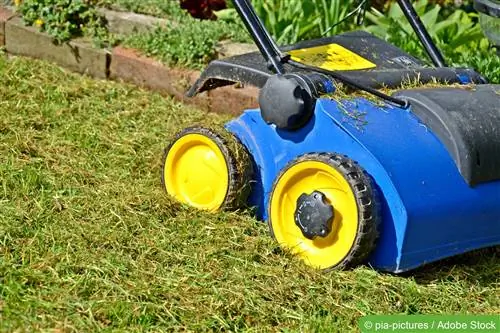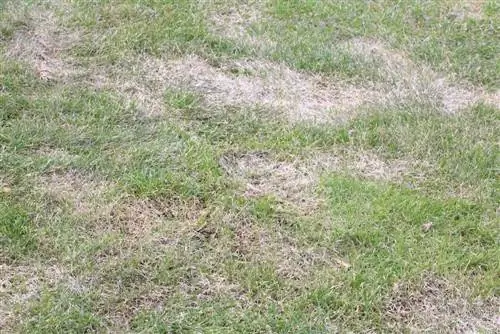- Author admin [email protected].
- Public 2023-12-17 03:39.
- Last modified 2025-06-01 06:48.
Everyone who wants to have a beautiful lawn must scarify at least once a year. Right or wrong? Of course wrong. Why? Why does the professional do it? And why is it pointless in the private garden?
Dethatching is the vertical slitting of the turf to remove thatch. In the professional sector, i.e. on football pitches and golf courses, in stadiums and arenas, the most important thing is that the grass can be walked on and played on in any weather. The quality of the turf only comes second. In order to achieve this high level of resilience and water permeability, the grass base layer, i.e. the layer in which the lawn grows, must consist mainly of sand. This composition of the turf base layer is regulated in DIN 18035 with regard to the grain curve (the distribution of grain sizes). The attempt here is to achieve maximum water permeability with the best possible shear strength. As a rule, a turf base layer today consists of 90% sand and 10% sandy topsoil. A soil that is so poor and hostile to plants that a halfway sensible farmer wouldn't even sow rye, sterile without any soil life, but maximally permeable to water. In order for good lawns to thrive on such soil, specialists and special care measures are necessary.
Due to the lack of soil organisms, the natural lawn thatch that is created by leftover mowing material does not break down, as is the case on natural garden soils, but must be removed manually by grooming and scarifying. When the lawn is covered with studs, green grasses are also tamped into the ground and are partly decomposed anaerobically. This can cause a hard, water-repellent felt that impedes water permeability. That is why the thatch is bad and undesirable in the professional sector and must be removed using forceful measures that will definitely damage the turf. For professionals, this measure always consists of four work steps: scarifying, sanding, reseeding and fertilizing. Scarify to remove the thatch, sand to increase water permeability and dilute the remaining thatch, re-sow to close the battered turf again and fertilize to strengthen the remaining grass.
In a private garden, the ultimate goal is not water permeability, but rather a beautiful lawn. On good garden soils there is never more than a centimeter of loose thatch, which is important for the turf. So thatch is not the problem. What is often the problem in private lawns is moss. But moss has nothing at all to do with thatch. Moss is an indicator plant for nitrogen deficiency. Moss always appears - and only then - when there is not enough fertilizer and the soil is nutrient-poor. This usually happens first in the crown area of trees and hedges, which is why the rumor persists that moss comes from shade and moist soil. In reality, in these areas the nutrients are used up more quickly by the shallow suction roots of trees and shrubs and there is simply more need for fertilizer. Of course it is the case that fertilizer, especially organic fertilizer, is more difficult to convert in shady areas, but this is not the cause but rather makes it more difficult. Moss does not appear where there is sufficient fertilization and disappears immediately when nitrogen is applied.
What happens if a mossy lawn is scarified to remove the moss manually? On the one hand, lawn plants that are already stressed and hungry are also injured and the leaf and root mass is destroyed, and on the other hand, real runways are created for weed seeds, especially in the spring, especially for the dandelions, which already fly in early spring. The more often you scarify, the more you damage the turf, the more weeds you get and the faster the lawn becomes unsightly.
Some people say the lawn also needs air and that's why you should scarify it. Then why cut into leaves and roots? If there really was a kind of grass lung directly beneath the earth's surface, why not ventilate large areas instead of cutting up the grasses? If I project that onto us humans, it would mean that we should have an arm or a leg chopped off every now and then so that we can breathe better. That doesn't sound very consistent.
In reality, lawns don't need more air than they already have around them, they just need more fertilizer. 3 - 5 fertilizer applications per year are usually necessary to maintain a perfect lawn and the less you damage the turf, the nicer the lawn is and the fewer weeds can colonize. So it's better to sell your scarifier and use the proceeds to buy a few bags of fertilizer; the lawn will benefit more from this than from constant maintenance stress caused by mechanical measures.
| Editor's note: Thank you for providing this article and the critical review of scarifying by Günther Schwab (www.rasenblog.de), Managing Director of Horst Schwab GmbH. |



